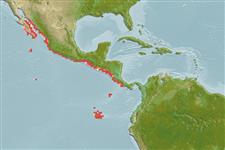Élasmobranches (requins et raies) (sharks and rays) >
Torpediniformes (Electric rays) >
Narcinidae (Numbfishes)
Etymology: Diplobatis: Greek, diploos = twice + Greek, batis, -idos = a ray (Raja sp) (Ref. 45335).
More on authors: Jordan & Gilbert.
Environment: milieu / climate zone / profondeur / distribution range
Écologie
marin récifal; profondeur 3 - 94 m (Ref. 96339), usually ? - 65 m (Ref. 114953). Tropical; 28°N - 2°S, 113°W - 83°W (Ref. 114953)
Eastern Pacific: Gulf of California to Ecuador.
Taille / Poids / Âge
Maturité: Lm ? range ? - ? cm
Max length : 25.0 cm TL mâle / non sexé; (Ref. 9259)
A nocturnal and solitary species found on sand and rock bottoms, in bays and on coral reefs (Ref. 12951). Feeds on small crustaceans, worms, and fishes (Ref. 37955). The smallest adult males known ca. 15 cm TL, females ca. 18 cm TL (Ref. 114953).
Life cycle and mating behavior
Maturité | Reproduction | Frai | Œufs | Fécondité | Larves
McEachran, J.D., 1995. Narcinidae. Rayas eléctricas. p. 769-771. In W. Fischer, F. Krupp, W. Schneider, C. Sommer, K.E. Carpenter and V. Niem (eds.) Guia FAO para Identification de Especies para los Fines de la Pesca. Pacifico Centro-Oriental. 3 Vols. FAO, Rome. (Ref. 9259)
Statut dans la liste rouge de l'IUCN (Ref. 130435: Version 2024-2)
Utilisations par l'homme
Pêcheries: sans intérêt
Outils
Articles particuliers
Télécharger en XML
Sources Internet
Estimates based on models
Preferred temperature (Réf.
123201): 22.4 - 28.9, mean 26.4 °C (based on 72 cells).
Phylogenetic diversity index (Réf.
82804): PD
50 = 0.5625 [Uniqueness, from 0.5 = low to 2.0 = high].
Bayesian length-weight: a=0.01413 (0.00680 - 0.02934), b=2.87 (2.68 - 3.06), in cm total length, based on LWR estimates for this species & (Sub)family-body (Ref.
93245).
Niveau trophique (Réf.
69278): 3.3 ±0.48 se; based on food items.
Résilience (Réf.
120179): Faible, temps minimum de doublement de population : 4,5 à 14 années (Assuming fecundity<100).
Fishing Vulnerability (Ref.
59153): Low vulnerability (15 of 100).
🛈
Nutrients (Ref.
124155): Calcium = 14 [2, 221] mg/100g; Iron = 0.518 [0.044, 5.651] mg/100g; Protein = 15.7 [11.5, 20.1] %; Omega3 = 0.119 [0.038, 0.345] g/100g; Selenium = 28.3 [4.6, 136.1] μg/100g; VitaminA = 62.7 [4.4, 812.4] μg/100g; Zinc = 1.43 [0.10, 16.00] mg/100g (wet weight);
